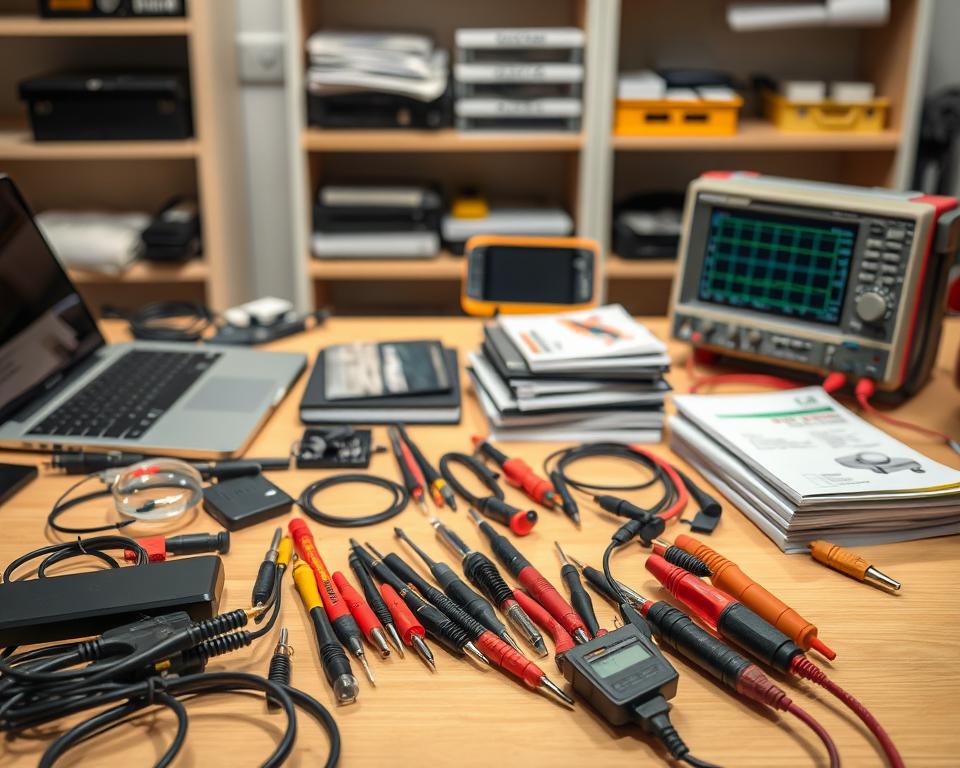Anúncios
apps qa — what does that mean for your product and your users?
Can a few smart checks stop crashes and keep people using your mobile app?
You need clear testing that links quality to fewer crashes and faster load times. 71% of uninstalls happen after a crash, and slow start times push 70% of users away. That makes testing a core part of software development for any app.
Testing spans functionality, usability, performance across networks and battery states, security, localization, payments, API reliability, streaming, builds, and memory leaks. A structured approach cuts risk from device and OS fragmentation and helps you keep the product steady for every user.
In this guide you’ll see why early checks in development matter, how assurance sets standards while tests verify them, and where real-device coverage, API checks, and load tests fit in. Practical examples and action steps will help you scope tests and tie results to release decisions.
Introduction: apps qa basics and why it matters today
Mobile app testing gives you clear signals about stability, speed, and security. You want an honest view of how your product behaves in the real world. Simple checks early on can cut crash-driven uninstalls and slow-start abandonment.
What “apps qa” covers in mobile development
What “apps qa” covers in mobile development
Testing covers functional flows, performance under varied networks, memory and battery stress, and basic security checks. Performance tests consider different networks and battery levels so your app reacts well to everyday conditions.
Why crashes, load time, and security shape user trust
Why crashes, load time, and security shape user trust
Data shows 71% of uninstalls come after a crash and 70% of users abandon slow-loading apps. Those numbers link directly to retention and revenue. Prioritize devices your audience uses via analytics instead of trying every handset on the market.
- Plain map of planning, standards, and verification so you place tests in your development timeline.
- Real conditions testing for spotty networks and low battery to reduce real-world failures.
- Focused coverage using analytics to pick devices that matter to your users.
- Fast wins in the first 30 days: pick top tasks, log risks, and run early checks.
Apps QA vs. QC: What’s the difference and why you should care
Define standards early so tests can prove the product meets them.
Quality assurance is the system that sets standards across the lifecycle. It covers requirements analysis, defect tracking, report formats, and the processes you follow to prevent defects.
Testing is one part of that system. Tests verify that code meets requirements. They show whether a build meets acceptance criteria.
Quality Assurance: processes, standards, and prevention
QA creates the playbook. You write clear requirements, define environments, and set acceptance rules. This makes prevention repeatable.
Quality Control: validation, verification, and release readiness
QC validates that the processes were followed. It runs verification checks and gates releases with sign-offs and checklists.
Real-world workflow: from requirements to reports
- Requirements → acceptance criteria and traceability.
- Test design → environment setup and execution.
- Defect tracking, retest, and root-cause analysis.
- Reports that give concise risks and next steps for decision-makers.
“Keep reviews aligned with milestones so feedback arrives when it’s cheapest to act.”
The essential mobile testing types you’ll actually use
Pick test types that map to real user journeys. Start with the flows people use most, then expand coverage to edge cases. Short, focused checks give fast feedback and reduce release risk.
Functional testing
Unit, integration, and end-to-end checks prove each feature works. For example, a travel app needs unit checks for date pickers, integration from search to details, and an end-to-end booking test that completes payment.
Usability testing
Run moderated and unmoderated sessions and compare against top fitness competitors. This reveals friction in onboarding, workouts, or subscription flows.
Performance testing
Cover load, stress, spike, and endurance tests. Run them on Wi‑Fi, 4G, and 5G so you see behavior under real network conditions.
Security, localization, and payments
Check data handling, permission hygiene, and KYC for payment flows like cards, bank transfers, Apple Pay or PayPal. Test translations, currencies, RTL layouts, and UI on various devices.
- API checks: validate contracts, error codes, and SLAs.
- Streaming: monitor buffering, bitrate shifts, and live-event stability.
- Build and memory: smoke, exploratory passes, and long-session leak hunts on low and high RAM devices.
Choosing tools for testing and quality assurance without the hype
Pick tools that match real needs, not marketing claims, so your testing delivers clear value. Start by naming the risks you must reduce—device coverage, API flakiness, or load spikes—and map tools to those risks.

Cross-browser and real-device coverage
BrowserStack gives thousands of real browsers and devices for manual and automated checks plus visual testing. Use Playwright or Cypress for fast web end-to-end feedback. Choose Puppeteer when Chrome-only automation suits your workflow.
Mobile app automation and API workflows
Appium drives iOS and Android via WebDriver so you can automate without altering the product. For api work, pick Postman or SoapUI to script calls, manage environments, and run mock servers early.
Performance, management, and code guardrails
JMeter handles distributed load across protocols; run headless for CI. qTest links tests to Jira and Jenkins for traceability and reporting. Add SonarQube to catch code smells and security gaps before they reach testers.
Standardize a small, integrated stack and document how each tool fits your pipeline.
- Rule: avoid tool sprawl—integrate into CI so results surface in pull requests.
- When to use BDD: use Cucumber only if stakeholders need readable scenarios as living documentation.
Designing solid test cases for mobile apps
Designing precise test cases turns vague requirements into repeatable checks that catch real problems. Start by tying every case to an acceptance criterion. That keeps requirements, expected results, and severity clear.
From requirements to test data: covering edge cases and real devices
Use analytics to pick target device models and OS versions. Note hardware quirks like low RAM or different cameras.
Create realistic data sets. Include negative inputs and boundary values. Add offline and flaky-network scenarios to mirror real life.
Prioritizing by risk: critical paths, payments, and authentication
Focus on high-risk flows first: login, account recovery, and payments. Protect revenue and trust before lower-risk features.
Include long-session and background/foreground tests to find memory and lifecycle issues.
- Convert requirements into clear steps with expected results.
- Assign device state, setup/teardown, and data resets for reproducibility.
- Tag cases by risk and keep them living documents.
Dica prática: Read a concise guide on test design at test case design to refine your process.
“Write lean steps, avoid duplication, and link each case to a requirement for traceability.”
Integrating apps qa into CI/CD and day-to-day development
Make CI your safety net so code changes reveal defects before they reach users. Run unit and API checks on every commit to shift testing left and keep small problems from multiplying.
Shift-left API and unit tests to catch issues early
Trigger fast unit suites and lightweight API checks on pull requests. That finds regressions close to the code author and speeds resolution.
Build gates: smoke tests, scripted checks, and exploratory passes
Create a quick smoke suite as a build gate. Let heavier automation run after the gate passes. Schedule short exploratory sessions per build to spot gaps scripted checks miss.
Observability and flaky test handling for faster feedback
Publish dashboards that link tests to requirements and recent commits for clear triage. Quarantine flaky tests, track them, and fix root causes instead of masking failures.
- Parallelize automation to cut queue time and keep feedback loops tight.
- Tag jobs by risk so the release candidate shows what must pass.
- Keep environments deterministic with controlled test data and reset state to reduce false positives.
Define ownership for failures so issues move quickly from detection to resolution.
Performance, usability, and security: practical checks that move the needle
Focus on a few hands-on checks that show whether the application truly performs for real users.
Speed under real conditions: battery levels, networks, and devices
Measure startup and key screen times on Wi‑Fi, 4G, and 5G. Run each test at full, medium, and low battery so you see how the app performs when power is constrained.
Include load, endurance, stress, and spike tests to catch gradual slowdowns, memory creep, and lifecycle issues across devices.
Human-centered usability: accessible flows and clear feedback
Run short moderated and unmoderated sessions to watch users complete core tasks. Check labels, error messages, and accessibility affordances.
Compare your core flows to top competitors to spot extra steps or confusing patterns that hurt conversions. Use small loops of usability testing to confirm fixes before wider rollout.
Security baselines: secure storage, comms, and permissions hygiene
Validate secure storage and TLS for all communications. Ensure least-privilege permissions and scan logs so sensitive data does not leak in error traces.
Add guardrails: retries, sensible timeouts, and offline support so network hiccups don’t break core features. Track simple performance budgets and alert on regressions in CI as part of your quality assurance practice.
Dica prática: document what you test and why; build a baseline you can improve over time.
- Measure startup and key screens across networks and battery states.
- Run quick endurance sessions to reveal slowdowns and leaks.
- Observe users, validate accessibility, and prototype fixes fast.
- Check storage encryption, TLS, permissions, and safe logging.
- Track budgets in CI and document tests so testers and engineers share context.
apps qa: common pitfalls, real examples, and how to avoid them
Many teams miss serious problems because they test only the newest handsets, not the hardware your users actually use. That creates blind spots and late surprises in production. Focus your effort where it reduces the most risk.
Device fragmentation and incomplete coverage
Pick a representative matrix from your analytics. Include top models, key OS versions, and OEM skins that change behavior.
Rotate coverage as market share shifts. Test OS upgrades and vendor skins to catch subtle breakages early.
Overlooking localization and right-to-left layouts
Validate translations with professionals. Check truncation, currency formats, and right-to-left mirroring.
Also test large system fonts and layout resizing so text does not overlap or clip in the UI.
Ignoring payment edge cases and third-party integrations
Harden payment flows against declines, partial approvals, timeouts, and currency mismatches.
Simulate slow gateways, duplicate callbacks, and webhook delays. Mock external APIs and run contract tests to stabilize integrations.
Exemplo: a routing OEM skin blocked a background retry, causing duplicate charges. After adding a retry policy and mock tests, the issue vanished.
- Keep a “gotchas” list from past defects for testers.
- Measure defect leakage and refine your tests each release.
Conclusão
Treat every release as a promise: testing and standards protect user trust and revenue.
Quality assurance defines the rules; verification confirms the product meets them. Keep your focus on the top risks—crashes and slow starts—because they drive most churn and hit retention hard.
Pick tools that match your workflow, integrate them into CI, and keep the stack small and documented. Run mobile app testing that includes real-device checks, api contracts, and simple performance budgets so the app performs where users live.
Be pragmatic: pilot new automation or services in small scopes, verify claims with trusted sources, and update tests as your software and usage change. Use a short checklist at release time so you spend time on what matters most.



